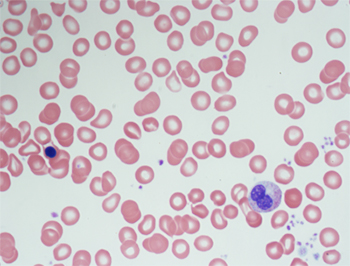A blood test result more typically seen in disorders associated with bone marrow diseases was found in a patient with COVID-19, a viral infection caused by severe acute respiratory syndrome coronavirus 2 (SARS-CoV-2). The findings were published March 25 in the American Journal of Hematology.
 Nucleated red blood cell on the left and immature white blood cells on the right
Nucleated red blood cell on the left and immature white blood cells on the right
Leukoerythroblastic reactions in blood usually indicate a significant deviation to the body's normal immune response. They resemble immature red blood cells (RBCs) and bone marrow cells (myeloid cells) circulating in the blood.
In a case study, researchers at UC Davis Health document leukoerythroblastic reactions in the blood work of the patient who is the first known case of community-acquired COVID-19 in the U.S.
"The unusual findings of leukoerythroblastosis in a patient with COVID-19 are very important to note," said John Paul Graff, assistant professor of hematopathology at UC Davis Health and senior author on this study. "It is not what one would expect in a 'typical' viral infection."
COVID-19 and blood analysis
A healthy woman in her 40s suddenly developed flu-like symptoms that led to admission at her local community hospital. Her chest X-ray and CT scans at the time showed signs of pneumonia. As her respiratory symptoms worsened, the patient needed intubation and ventilation. She was transferred to UC Davis Medical Center for advanced care.
Upon admission, the patient's initial blood tests revealed a normal white blood cell (WBC) count, reduced level of lymphocytes (one type of WBCs), insufficient normal-sized RBCs and a normal platelet count. Three days later, the patient had an increased level of WBCs (leukocytosis) and above normal levels of immature neutrophil cells. Her blood test also showed a mild increase in the number of monocytes (immune cells) and a reduced level of lymphocytes.
The leukoerythroblastic picture reflected normal shaped and sized RBCs but in lower than normal levels (normocytic anemia), occasional immature RBCs (nucleated), a mild presence of RBCs with different sizes (anisocytosis) and rare tear-drop shaped cells known as dacrocytes. It also showed neutrophilia, highlighting the body's rush to produce WBCs to fight the infection.
As the patient got better, the neutrophilia resolved, and the other blood indicators were back to normal ranges. The patient has since been discharged and is recovering at home.
COVID-19 testing and suspicion of leukemia
"We hope to avoid unnecessary blood work-up and diagnostic testing in patients with COVID-19," Graff said. "If leukoerythroblastic reactions were cited in peripheral blood and the patient has a cough and pneumonia, we advise physicians to order COVID-19 testing instead of flow cytometry or bone marrow evaluation for suspicion of leukemia."
UC Davis Medical Center researchers on this study include Anupam Mitra, Denis Dwyre, Nam Ku, John Graff from Pathology, Michael Schivo from the Division of Pulmonary and Critical Care Medicine, George Thompson and Stuart Cohen from the Division of Infectious Diseases and the Department of Medical Microbiology and Immunology.
Article: Mitra et al. "Leukoerythroblastic reaction in a patient with COVID-19 infection" American Journal of Hematology. Published March 25, 2020. doi: 10.1002/ajh.25793






